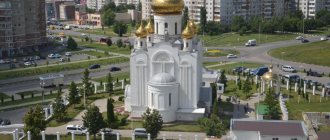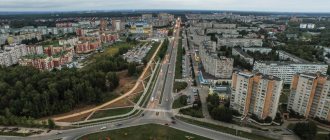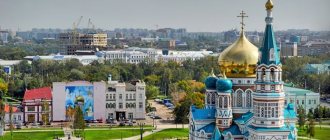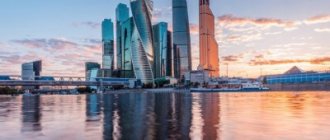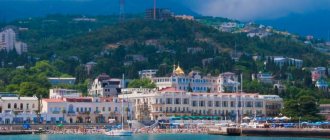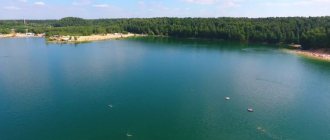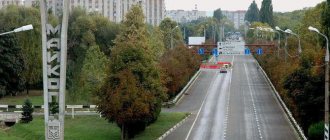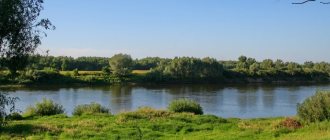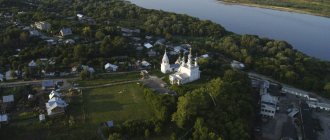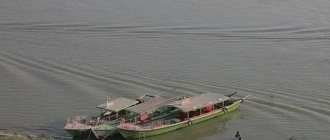- September 24, 2019
- Directions
- Molton
Smolensk is one of the large cities in the west of the European territory of Russia. Known as the administrative, cultural, industrial and historical center of the Smolensk region. The city has a long history, dating back to 863. Smolensk is listed as a hero city. Throughout its history it has performed an important defensive function.
Many people ask the question: where is Smolensk? This city is located in the upper reaches of the Dnieper River, at a distance of 378 km southwest of Moscow. The location of the city is advantageous from the point of view of transport logistics and trade. The dimensions of the urban area are 25 by 15 km. The area of the city is 166.35 km2. Number of inhabitants – 329,427 people. The height above sea level is about 240 meters. Smolensk is divided into 3 urban districts. The mayor of the city is Andrey Borisov.
The map below shows where Smolensk is located on a map of Russia.
Geographical features
Smolensk is located on the territory of the Smolensk Upland, on both banks of the Dnieper River. A feature of the relief is a large number of ravines and river gullies. Between them there are hills and ridges. There are 3 bridges across the Dnieper. The old part of the city is located on the highly rugged and high left bank of this river.
Time in Smolensk corresponds to Moscow.
The climate is largely determined by where Smolensk is located. It is moderately continental, quite mild. Winters are moderately cold and summers are relatively cool and humid. 738 mm of precipitation falls per year. The maximum occurs in summer, especially in July (90 mm).
Coat of arms
The coat of arms of Smolensk is presented in the form of a French shield with a historical version of the emblem of the locality. It is superimposed on the large golden star of the hero city and crowned with the cap of Monomakh.
There are two scarlet banners on the sides. They are connected by the St. George Ribbon. They depict the monogram of Emperor Alexander I, decorated with the imperial crown and chain of the Order of St. Andrew the First-Called. Under the structure there are two order ribbons: Lenin and Patriotic War, 1st degree. They are intertwined with a silver ribbon on which the motto is placed: “GLORIFICED BY THE FORTRESS.” It is written in black letters.
The artistic composition was adopted by decision of the 9th session of the Smolensk City Council of the II convocation dated April 27, 2001 No. 111.
Population of Smolensk
The city's population grew rapidly during the Soviet era, remained almost unchanged in the 1990s, and declined slightly in the 21st century. In 2022, the number of residents was 329,427 people, which puts the city of Smolensk in 59th place among Russian cities. The reason for the unfavorable demographic situation is its proximity to the Russian capital. Many people choose to move there to earn more. First of all, young, educated and active city residents are leaving. Another negative factor is the poor economic situation in the Smolensk region. Smolensk has a large proportion of elderly population, and the number of women is 90 thousand more than men. The average age of residents is 41 years, which is 2 years more than in the country as a whole.
The national composition is dominated by Russians (94.8%). Belarusians and Ukrainians - one and a half percent each. The share of Gypsies, Armenians and Tatars is even smaller.
Story
The history of Smolensk begins in ancient times. Pre-Slavic tribes lived on modern territory. The first mention of the city dates back to 863. The 12th century saw the heyday of the principality of the same name. In the 16th century, the settlement was annexed to the Russian state. In the 18th century it received the status of a provincial town. During this period, rapid construction began and trade developed.
At the beginning of the 19th century it suffered from the invasion of Napoleon's troops, but soon recovered. An important railway junction was built there. He contributed to the emergence of large industrial facilities.
On October 1, 1929 it became the center of the Western Region. After a two-year occupation during the Second World War, the city began to actively settle down. This was facilitated by the government's order to prioritize restoration. After the collapse of the USSR, the economy and social sphere of the settlement fell into decay.
City zoning
Smolensk is divided into 3 districts: Industrial, Leninsky and Zadneprovsky. Leninsky district is the oldest. The bulk of architectural monuments and parks are located here. It also has the most cultural sites. Another feature is the large number of ravines that prevent the construction of new houses.
The Zadneprovsky district is known for the fact that a plane carrying the Polish president crashed here. The area is home to aircraft and auto component factories. Locals call this part of the city Pokrovka.
The industrial area was a concentration of industrial enterprises. At least that's how it was in Soviet times. Now the situation has changed somewhat and this is a very densely populated area with developed residential buildings.
Outstanding personalities
The activities and lives of many famous personalities are connected with Smolensk. Someone was born in this city, and someone spent a certain period of their life in this place:
| M. V. Isakovsky | A talented poet, creator of many masterpieces, was born in the Smolensk region, just look at his beloved song “Katyusha” |
| N. I. Rylenkov | Born in the Smolensk region, prose writer, poet, talented translator |
| Boris Vasiliev | The Smolensk region is his homeland, a domestic writer of the 20th century, who created such works as “Tomorrow there was a war”, “Not on the lists”, “And the dawns here are quiet” |
| Yuri Gagarin | The first cosmonaut is also a fellow countryman of the residents of the Smolensk region |
| Yury Nikulin | A talented actor and famous circus performer, born in Demidovo, Smolensk region |
| Anatoly Papanov | Talented film and theater actor, born in Vyazma, Smolensk region |
| Maria Tenishcheva | One of the few female celebrities of the region, who is a great philanthropist and collector of unsurpassed masterpieces |
| M. I. Glinka | Belongs to the famous Polish family Glinka of the Smolensk province, was an unrivaled composer of his period |
This list can be continued indefinitely, since the region is famous for its eminent ancestors, as well as figures of the modern period.
Infrastructure and housing and communal services
This area can rightly be called the main disadvantage of this city. The cost of housing and communal services amounts to several thousand rubles per month, while their quality leaves much to be desired. It is especially difficult for residents of multi-storey buildings.
Many residents are unhappy with the massive cutting down of green spaces, which gives the city an unattractive appearance.
Interesting Facts
Interesting facts about the city are revealed by its name:
- there are several versions of its origin - from the name of the Smolnya River, which means “black soil” or from the ethical name of the craft of local residents who tarred the ships of merchants moving along the river from the Varangians to the Greeks;
- in 1901 in the Hall of the Noble Assembly in the quarter of modern street. Lenin, the first moving film was shown, organized by the French entrepreneur J. Dursen;
- the legend of the Veselukha Tower became the inspiration for the writer Alexei Tolstoy, who created the story “Count Cagliostro”, which became the basis for the film “Formula of Love”;
- the manufacturer of the iconic yellow taxis that have become a New York tradition is a former resident of Smolensk;
- and the painting “Smolensk Newspaper”, painted by Marc Chagall in 1914, is kept in the Philadelphia Museum of Art.
Smolensk is a beautiful city with a rich and turbulent history, an interesting culture that has been modified by many peoples. It is a large industrial city, as it has enormous potential and achievements, and is also located in the center of the interweaving of trade and economic hubs.
In addition, this is the land of many famous and talented personalities of the past and modern periods.
Climate and ecology of Smolensk
Smolensk is located on the Central Russian Upland, hence the climate - continental with pronounced moderation under the influence of the Atlantic Ocean. In ordinary words, quite comfortable for living, without severe frosts or sweltering heat. Sometimes there are years when there are frosts below 30 degrees for several days, or the same heat with a plus sign. But this is an exception.
The average annual temperature is kept within 5 degrees: in winter about minus 10-14 degrees, average summer temperatures are within 20 degrees Celsius.
Local residents say that the climate in Smolensk is similar to London: high humidity, in some periods up to 98 percent, frequent rains, fogs. 160 days of cloudy and rainy days a year.
But there is no smog, like in the capital of Foggy Albion, in Smolensk. In post-Soviet times, the production of many types of products, the production of which had a negative impact on the environment, ceased. In particular, the production of fluorescent lamps has been completely stopped - mercury vapor has disappeared.
Smolensk still remains one of the greenest cities in Russia. A large number of parks and squares are located in the central part of the city. There are large green areas in all districts of the regional center. The total area of green spaces is one third of the city's territory (166.35 kilometers).
What to bring from Smolensk
What to bring from Smolensk? This question is asked by almost every traveler who finds himself in this city.
Unfortunately, even the city residents themselves find it difficult to name some original memorable souvenirs that are worth taking with them from Smolensk. Traditional magnets, mugs, plates, T-shirts are, perhaps, unlikely to achieve such status.
Otherwise, embroidery and linen products, and clay bells are brought from Smolensk. Girls should ask the price for products from a local jewelry factory. Men will certainly be interested in local alcoholic drinks and liqueurs.
Automobile highways
Federal highways pass through Smolensk:
- M1 "Belarus" is a transit road to the Republic of Belarus, the total length of which is 611 km. It is part of the European route E30. The highway originates in Brest, on the state border with Poland. It goes through Minsk, Orsha, Baranovichi. The final point of the route is Radki, on the state border with Russia.
- P120 is a public road that has the status of an object of federal significance. The total length of the route is 445 km. The route starts in the city of Orel and goes through Smolensk, Rudnya and Bryansk. The final point of the route is the border with Belarus. The road surface of the route is concrete and asphalt.
- E30 is a European route that passes through the UK, Ireland, Russia, Germany, and Poland. The road originates in the Irish city of Cork and passes through London, Berlin, Rotterdam, Warsaw, Moscow, and Chelyabinsk. The final point of the route is the city of Omsk.
LiveInternetLiveInternet
Article from the newspaper "Arguments and Facts"
Over 1,150 years, Smolensk has changed hands many times, and some “neighbors” still consider the key city to be a disputed territory
In the 21st century, it seems that the period of colonial redistribution of the world has long passed. But despite this, disputed territories are a problem that worries many states. China seeks to defend the Diaoyu Island, the Japanese, calling it Shonkaku, prove their rights to ownership. Russia is resolving the issue with Japan regarding the Kuril Islands and Sakhalin. In Europe there are a number of unrecognized and partially recognized states, such as Transnistria and Kosovo. Such countries are not uncommon on other continents.
Everyone knows the conditions under which the Russian state was formed. Constant wars, continuous shifting borders, new enemies, new allies... Smolensk, the key city, has always taken on military adversities and defended the western borders of the state. Of course, it passed from hand to hand, but in the end it was again captured from the enemy.
White-red-white “Scyag” and “Tutishaya Republic”
On the desk of one of my colleagues there is a white-red-white flag. For a Russian who is little familiar with Belarusian life, this, of course, means nothing. So, today the red and white banner is an opposition flag, inherited by pro-Western “figures” from the Belarusian People's Republic of 1918-1919. The palette, by the way, matches the flags of Poland and Lithuania. Is it not the interests of these states that the opponents of the Lukashenko regime are looking out for?
If they ask me what is the most unpleasant thing in Belarus, I will answer without doubt: Russophobic literature. As a rule, these are books of a historical, or rather, pseudo-historical orientation. There are plenty of such “masterpieces” in almost any bookstore in Minsk.
Here are the most common theses of such books. 1. Russians are not Slavs, but Mongols (alternatively Finno-Ugric). 2. Belarusians are not Slavs, but Litvins. 3. The Russian language is primitive, significantly inferior, for example, to Polish, or even represents its simplification. 4. Russians and Belarusians differ in appearance, as representatives of different races, in mentality, culture, and the like. 5. Russia waged a huge number of wars against Belarus, Suvorov committed genocide of the Belarusian people. 6. Orthodoxy is the world's largest sect, alien to the Belarusian people. 7. Russia has usurped Belarusian territories throughout history. In particular, Smolensk. “Belarus” is a name imposed by the communist regime. The republic should be renamed “Tuteishaya”.
Such “pearls” are distributed in literature, periodicals, and multiply at incredible speed on the Internet. Such ideas, of course, are not born just like that: there are opinions that with their help they want to turn Belarus, as they say, towards Europe in front and towards Russia in back.
Is the city of Smolensk Belarusian?
“Smolensk is a Belarusian city!” - an axiomatic postulate of any Belarusian oppositionist, especially if we talk about the nationalist opposition. Moreover, some figures consider Bryansk and other territories of the modern Russian Federation to be Belarusian cities.
Was Smolensk historically Belarusian? Indeed, Smolensk once belonged to the territory of the Grand Duchy of Lithuania. But just like that, India belonged to Great Britain, Vietnam to France, Alaska to Russia, Mongolia to China. The list can be continued endlessly: the borders of states have changed repeatedly throughout history, and not only in the lands where the Republic of Belarus is located today. Is it worth trying to restore the “original” borders on the political map of the world? What then to do with the “young” states: Israel, Kosovo, Abkhazia?
Besides, who said that Belarus is the only legal successor of the Grand Duchy of Lithuania? What about Poland? Lithuania? The Belarusian opposition offends its neighbors over the rights to divide Russian lands!
Are there a large number of ethnic Belarusians living in Smolensk? Not so big in comparison with the bulk of the Russian population. In this regard, is it right to call the city primordially Belarusian? Based on the same criteria, Vitebsk can be classified as Russia (according to the majority of the Russian population).
So is it dangerous for a Russian to go to Belarus, say, for a weekend? No! In this country, everything is fine with public order. Nationalists (who, fortunately, are not in the majority) will not attack a Russian on the street, but they will brutally abuse him on the Internet. To paraphrase the great helmsman Mao, the Belarusian oppositionists can be called paper tigers. Most likely, they themselves understand which country Smolensk belongs to.
Sergey Martinovich, Master of History, graduate student of the Institute for Training of Scientific Personnel of the National Academy of Sciences of the Republic of Belarus, chief curator of the fund of the Vitebsk Regional Museum of History and Local Lore (Vitebsk):
“The question of the historical affiliation of Smolensk occupies the minds not so much of professional historians (for them everything has long been clear), but of publicists and politicians. In the 90s, some of the “holy” figures openly called for the “reunification” of the Smolensk region with Belarus. Their arguments boiled down to the fact that, firstly, before the revolution, the overwhelming majority of the population of the Smolensk province (or, at worst, the provincial center) were Belarusians, not Russians; secondly, Smolensk was part of the Grand Duchy of Lithuania and the Polish-Lithuanian Commonwealth; thirdly, the Belarusian Soviet Socialist Republic was proclaimed in Smolensk.
To understand the national composition of the population of the Smolensk region at the turn of the 19th and 20th centuries, it is enough to study the data of the All-Russian Census of 1897. And they give the following picture: in the whole province, 91.6% of respondents classified themselves as Russians, and 6.6% as Belarusians. 91.1% and 1.2% of Russians and Belarusians lived in Smolensk and Smolensk district, respectively. Only Krasninsky district had a numerical predominance of Belarusians - about 90% of them lived there. Less than one percent of Smolensk residents spoke the Belarusian language at that time. Of course, the Western Smolensk region is ethnographically connected with Belarus, but this proximity does not mean identity.
The fact that the Smolensk region became part of the Grand Duchy of Lithuania also does not mean that it belongs to the Belarusian lands. The Grand Duchy of Lithuania, along with the modern Belarusian lands, also included the Lithuanian, Ukrainian and Russian lands themselves. During the period of its greatest prosperity, the border of the Principality extended to Mtsensk, Tula and the archaeological Orel in the east, Toropets in the north. In addition, the Smolensk principality was annexed to the Grand Duchy of Lithuania by force - as a result of a two-month siege of Smolensk by the troops of Vytautas in 1404. About the heroic defense of the Smolensk fortress in 1609-11. from the Polish troops is widely known.
Regarding the formation of the BSSR in December 1918-January 1919. in Smolensk, this can be explained by the difficult circumstances of the Civil War and disagreements among the Bolsheviks. The initiative to create a state entity - the Belarusian Commune within the RSFSR - was almost simultaneously taken by the Minsk Council and the Regional Executive Committee of the Western Region and the front in Smolensk.
In the first case, it was about the creation of a united Belarusian-Lithuanian state entity (which did not find support from the chairman of the All-Russian Central Executive Committee Y.M. Sverdlov), in the second - about the convening of the All-Belarusian Congress of Communists, the creation of the Belarusian Communist Party and the Belarusian Workers' and Peasants' Government. During the debate about the future fate of the Western Region, the initiative of the Belarusian communists was supported by the People's Commissar for National Affairs I.V. Stalin, which ultimately resolved the issue of the future Belarusian state.
At the VI North-Western Regional Conference of the RCP (b) in Smolensk on December 30, 1918, the Communist Party of Belarus was created, and the history of the BSSR dates back to January 1, 1919. It must be said that at that time, not the entire territory of Belarus had yet been liberated from the Kaiser’s troops - they stayed in Grodno, in the southwest of the Minsk province, and Gomel was liberated from them only on January 14, 1919. Smolensk remained the capital of the BSSR for only a few days, On January 5, 1919, the capital was moved to Minsk.
Thus, Smolensk cannot be considered a Belarusian city.”
